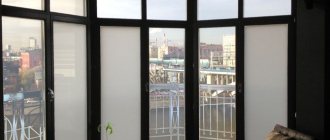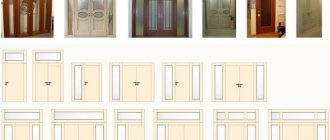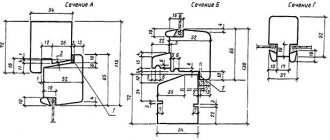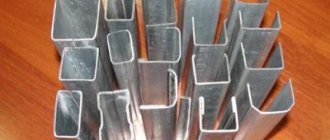Many people know the inconvenience of opening a window using a transom, since the handle itself is located at the top. In this regard, a special transom fitting was developed that has a lever opening at a very convenient height.
When moving the lever to the “down” position, the transom easily opens, and when “up”, on the contrary, it closes. The transom opens inward; it can have a rectangular, arched or trapezoidal shape.
In general, the remote mechanism for opening transoms is quite reliable, and most importantly convenient, as it has a fairly high pressing force. In addition, such a mechanism looks quite original and fits aesthetically into any interior.
Transom window opening
Using a mechanism for remote opening of transoms, using the example of ELEMENTIS FL-190, you can close, open and fix tilting sashes of windows made of wood, PVC and aluminum, having a weight, together with a double-glazed window, of no more than 40 kg/m2 and no more than 80 kg of the entire doors
Installation and repair of remote opening of windows, transoms in Moscow and the Moscow region
If you need to install a device for remote opening of windows, transoms, or carry out maintenance and repairs, then call us at 8 (495) 104-39-72 or leave a request by mail
We carry out all types of installation, repair, adjustment, replacement of parts, any brands, fanlight opening mechanisms, for plastic windows (PVC), also wooden and aluminum: Geze; Hautau; Elementis; GU ventus;Stublina.
Sash widths range from 440mm to 3600mm; depending on the width of the sash, it is possible to install additional scissors to ensure maximum pressure. Universal mechanisms are designed for profiles with overlap heights from 0 to 25 mm.
With the help of transom opening devices, you can easily open semi-arched and arched windows, double and triple structures, windows with bevels, and so on. As for the opening width, it is 190 mm. The body is quite compact, beautifully shaped, it is made of light metal, and the parts themselves are made of corrosion-resistant steel.
Main advantages:
- Thanks to the presence of three locking points in the scissors, the pressing force of the window sash is significantly increased and improved - at the same time, the structure itself is locked very tightly, this accordingly improves the thermal insulation qualities. As for adjustment and installation, such work is carried out very quickly. The pressing force of the sash can be adjusted thanks to the sash hooks on the scissors. It is quite possible to securely fix the sash in the open position, since it is resistant to wind loads.
- For absolutely any shape. Flexible rods are perfect for semi-arched and arched windows. Moreover, they are offered in completely different color options, they are easy to move and are even suitable for use in devices with one or even two scissors. Even if the radius is small, the system works smoothly, reliably and accurately.
Source: wikipro.ru
Applying an element
The transom of a window is found quite often, but people do not always pay attention to it, without separating it into a separate part that has any name. The shape of the transom can be different: for example, there are designs in the shape of a trapezoid or arch. The most common element option is a square or rectangle. Less often you can find a polygon or other non-standard shapes, the choice of which depends on the customer’s design intent, or the unusual shape of the window opening. The window transom is most often part of a PVC profile structure; less often, a separate installation of the element is provided, and the buyer has the choice of installing the structure with or without it.
You can see a window with a transom if its size is larger than average. Such an element will not look good on small windows and will not fit into the design. The optimal window size should be more than 170 cm. A window transom is needed not only to make the appearance of the structure more attractive and visually enlarge it, but also to let more light into the room.
The design allows you to create large windows, while significantly reducing the load on their sashes and the structure itself. The room becomes brighter, the windows visually become much larger, adding a feeling of free space to the room. Eliminating excess pressure on a PVC structure allows you to increase its service life and facilitate operation. Using this technique will allow you to create a large window opening without the need to install a bulky, expensive window. Such windows are used in private houses and apartments with high ceilings. Large window openings not only look attractive, but also make the room quite bright.
When choosing a window with a transom, it is best to order a design in which it will open - this will make it easier to care for the window, it will be easier to clean, and will also provide an additional window for ventilation.
Plastic windows have long gained popularity. But many are no longer satisfied with standard products. Do you need a window in a plastic window? Read about this in detail on our website. About
Remote window opening
Remote opening is a convenient option that will save you from having to climb a stepladder every time to close a window that is large or located too high.
Remote control will allow you to open and close plastic windows, no matter what part of the room you are in, one or several at once, completely or at a strictly defined distance.
It is enough just to install a special mechanism when making a window - and the process of opening and closing it will become as comfortable as possible.
Today, PVC windows are increasingly technologically advanced designs with the widest capabilities. The result is windows equipped with the latest technology. Windows with remote control transoms are among the most popular solutions.
In addition to the obvious comfort when opening and closing windows using automation, this also allows you to reduce the load on the tilt-and-turn mechanism, which affects the durability of the profile and the window as a whole. An automatic drive for opening and closing provides a precisely dosed load, reducing the depreciation of the main mechanisms.
Source: plastok.ru
Window transoms: purpose, shape, types
What a transom is can be clearly explained using the example of a passenger railway car window - this is a rather narrow horizontal sash, which in this case can be tilted for ventilation.
In residential buildings, public and industrial buildings, transoms can be not only folding, but also blind. As a rule, they are installed in high openings, although they are also found in windows of regular sizes.
In each case, the transom has its own purpose. And it can be represented as one or more functions from the following list:
- Ventilation without drafts. Inherent only for folding transoms. They can be manually forced, with remote mechanical opening using traction (regular or with a cardan), with electric drive, or combined.
- Increased rigidity of the overall structure. Typical for windows with a common frame. Although with separate fastening in the opening, the frame of the main window will be smaller and stiffer.
- Reducing the load on hinges and swing sash mechanisms. The service life of hinges and window mechanisms depends on the weight of the sash, and the allocation of a separate movable or fixed transom in the glazing of the opening reduces it.
- Compliance with the architectural style of the facade. The shape of the upper transom can be any: rectangular, square, triangular, semicircular or oval. The last three types refer to arched windows, for which a transom is a mandatory element.
- Safety. In this case, we can talk about different options. For example, windows with a blind lower part and a movable upper transom can be installed in a children's room; and windows with a blind lower transom and hinged sashes are used when the window sill is made wide and a place for rest is equipped there.
- Smoke removal. It is no coincidence that this is a separate item - there are special fireproof transoms for industrial and public buildings. They have their own regulatory requirements for height (minimum 2.2 m) and opening (remote with electric drive, backed up by an emergency manual mechanism).
Based on the total number of sashes, there are three common types of window designs with transoms:
- single leaf - transom and one sash.
- bivalve — transom plus two main doors;
- tricuspid — transom plus three main doors;
Transom mechanisms
Mechanical fanlight openers GEZE (pro-Germany) are irreplaceable devices (devices) designed for remote opening/closing of windows located in a place inaccessible to manual opening, used for comfortable daily ventilation.
In order to open or tilt a transom (hinged window) without an installed Geze transom remote control mechanism, a person will have to at least stand on a chair, and in the worst case, use a stepladder or ladder.
To solve this problem, the range of products we offer includes mechanical and electric Geze transom remote control openers made in Germany. This is an ideal solution for remotely tilting or opening aluminum and metal-plastic windows at high heights, with sash widths from 360 mm to 3600 mm
The mechanism consists of movable scissors, an angle bracket, a rod, a handle and a decorative casing. All visible parts are made of anodized aluminum, standard colors white, silver, dark brown, RAL on request.
The scissors are attached to the opening part of the window, and the windows themselves are opened by tilting, with an opening width of up to 260 mm. It is possible to equip it with rigid or flexible (impost - crossbar) rods.
Thanks to their compact dimensions, GEZE fanlight openers do not require much installation space. The scissors are equipped with an additional device that prevents unauthorized persons from unlocking the scissors.
Care and maintenance
The transom is essentially a folding window, so adjustment and maintenance follow the same rules. Each manufacturer of window fittings has its own technical documentation (drawings, descriptions, instructions), which defines the sequence of installation and adjustments. In order for the mechanisms to serve for a long time, you must adhere to general care recommendations.
For tilt windows with friction scissors they are as follows:
- Regularly clean the fittings from any kind of dirt with a slightly damp sponge (or clean cloth). Use only weak and neutral pH solutions.
- Check all moving components of the mechanism (pulls, handle, scissors, hinges) to identify deformations and mechanical damage.
- Monitor the condition of the drive fasteners and hinges.
- Lubricate moving parts and locking points.
- Replace worn parts in a timely manner and carry out the adjustments specified by the manufacturer.
- Ensure correct and smooth operation of the transom drive.
Subscribe
Geze fanlight opener options
GEZE OL90 N is a flat fanlight opener for vertically installed rectangular windows with an opening width of 170 mm.
This fanlight opener is used on vertically built-in rectangular windows with inward-opening hinged, hung, revolving and mid-turn sashes made of wood, PVC or light alloy.
Thanks to the flat design of the scissors and the rod outlet, little space is required above the window sash and on the side. Installation is hassle-free since the scissors and rod are mounted from the front. The appearance of the facade remains unchanged.
The sash retainer in the scissors ensures a secure fit of the sash. Despite this, the easy detachment of the scissors allows you to clean the window from the inside and outside.
DIY transom above the door
What to do if the doorway has non-standard dimensions, but there is no transom suitable for your taste or dimensions on sale? The solution to the problem is to make a transom above the door with your own hands! Despite the widespread belief about the complexity of the process, manufacturing a structure will not cause problems if you approach the matter from the right side.
To install interior or entrance doors with a transom yourself, you will need the following materials:
- box timber;
- a set of wooden or plastic wedges;
- polyurethane foam;
- platbands and additions;
- fasteners;
- silicone sealant (if glazing is planned).
The transom manufacturing process includes seven sequential steps
First, the door opening is measured. This stage must be approached with care and responsibility, since the quality of the final product depends entirely on how correctly the measurements are taken. We arrange the box. We install the transom box made in the previous steps in the space allocated for it above the interior door.
It is advisable to use wedges to level the structure. All cracks should be filled with foam and wait until it dries completely.
Only after the box is in place can you proceed directly to glazing the assembled structure. Subsequently, extensions and platbands are installed, performing a decorative function.
This is done in four steps:
- we mark the box beam, taking into account the required gap between the lintel and the ceiling;
- cut off excess pieces of timber exactly according to the markings, carefully so as not to damage them;
- lay out the pre-assembled box on the floor;
- We twist the box parts using self-tapping screws. It is recommended not to tighten them all the way, since during installation in any case the structure will have to be leveled.
GEZE OL90 N for special shapes
— a flat-shaped fanlight opener for beveled and triangular, for semicircular and arched windows.
These fanlight openers are used on vertically mounted beveled or triangular windows, or in the form of semi-circular and arched windows with inward opening hinged sashes, made of wood, PVC or light alloy.
With the help of a flexible angular transmission, different inclination angles can be realized. Thanks to the flat design of the scissors and the rod outlet, little space is required above the window sash and on the side, installation is carried out without problems, since the scissors and rod are installed from the front. The appearance of the facade remains unchanged.
The sash retainer in the scissors ensures a secure fit of the sash. Despite this, the easy detachment of the scissors allows you to clean the window from the inside and outside.
Installation and repair of remote opening of windows, transoms in Moscow and the Moscow region
If you need to install a device for remote opening of windows, transoms, or carry out maintenance and repairs, then call us at 8 (495) 104-39-72 or leave a request by mail.
We carry out all types of installation, repair, adjustment, replacement of parts, any brands, fanlight opening mechanisms for plastic windows (PVC), also wooden and aluminum: Geze; Hautau; Elementis; GU ventus;Stublina.
Window with a window - why do you need a small transom?
A window is a small, usually opening sash, a transom of a window, designed to ventilate a room.
The vents were located at the top of the window. The height was calculated so that an adult of average height could reach it without the use of additional means - a chair or stepladder.
Photo: window with a window in an old house, © oknamedia
Where did the word "window" come from? In Russian it appeared by transformation from the Polish word “fortka” (door). "Fortka", in turn, was borrowed from the German language, in which "die Pforte" means "gate". But this word is not original either. The “pedigree” of the window goes back to the times of the Roman Empire, from the Latin word “porta” (door, gate).
If you refer to GOST 23166-99 “Window blocks. General technical conditions”, then the following definition of a window is given there: “A window is a sash element with dimensions, as a rule, not exceeding 350x450 mm, connected by means of a hinge to the bars of the sash or frame, intended for ventilating the room.”
From the GOST terminology it can be understood that the main purpose of the window is to ventilate the room. But why is this task set specifically for the window? After all, according to the same GOST, all window sashes (with a few exceptions) must be opening. This means that by opening any of them, you can ventilate the room. And why were vents used in windows for a long time in Russia?
The window is a “breath” of fresh air
It's all about the climate. In most of Russia, low temperatures prevail in winter. Ventilation with an open sash in such conditions leads to hypothermia of the room. If you open the door a little, cold air will still quickly enter the lower part of the room, which will lead to discomfort - the cold will “walk on your legs.”
Photo: in winter, the window remained the only source of fresh air through the window
The window was located in the upper part of the window, so when ventilating, cold air from the street did not immediately reach the floor, having time to partially mix with the warm room air.
Window - protection against penetration through the window
Another advantage of vents is protection against penetration. The size of the windows was calculated in such a way that attackers could not crawl through it. In the summer, they were practically not closed, even when leaving the house. At one time there was even a special category of thieves - window burglars. Some involved children for this purpose, but these were not mass cases.
Photo: Thefts through the window were rare due to its small size
For many decades, the window as a whole coped with its functions, based on the previous capabilities of windows, and was an important part of them. How has the situation changed with the advent of modern windows? Is there still a need to complete the window with a window?
Modern windows can be made with hinged or tilt-and-turn sashes.
Ventilation using a swing flap:
When the swing door is opened for ventilation in winter, the room quickly becomes overcooled.
Photo: ventilation using a rotary sash in winter will lead to rapid hypothermia of the room
Combs were subsequently widely used for ventilation in swing doors.
| A comb is a window opening limiter with several recesses for adjusting the amount of ventilation. |
Using a comb in the windows did not solve the problem of comfortable ventilation. The air passed inward from the level of the window sill to the top of the sash. The likelihood of getting sick in winter with such ventilation increased.
Ventilation using a swing-out flap
The invention of the German engineer Wilhelm Frank (Roto Frank) in 1935 marked the beginning of a new era - the tilt-and-turn window. The Roto fittings made it possible not only to open the sash, but also to move it to the folding position for ventilation. Roto Frank has become a world leader in the production of tilt-and-turn hardware for windows and doors. Every 3rd window in Russia is sold with Roto fittings.
The first Euro-windows with tilt-and-turn fittings began to be supplied to Russia from Europe in the early 90s. Then the functions of the tilt-and-turn fittings were limited to tilting by 140-150 mm.
The swing-out flap made it possible to ventilate the room more safely for health. With tilt ventilation, cold air mainly enters the upper part of the room and then gradually falls down. Ventilation is more comfortable and gentle than with an open flap: “the head is cold and the feet are warm.” The folding position is safer, as it allows you to secure the sash against gusts of wind, and when it rains, drops will not flow inside.
Photo: the standard folding mode is optimal for the warm season. In winter, it can lead to rapid hypothermia of the room
Despite these benefits, at low temperatures, the tilt mode also causes the room to become overcooled. Therefore, buyers continued to order modern windows with pivot or tilt-and-turn vents.
Photo: tilt and turn window in tilt mode
Installing a window in Euro-windows before 2004 (before the advent of micro-ventilation) was to some extent justified in order to avoid overcooling the room in winter.
GEZE OL90 N for outward opening hung windows
— a flat-shaped fanlight opener with an anti-burglary lock.
This fanlight opener has a beautiful new design and is used on vertically built outward opening hinged windows made of wood, PVC or light alloy with an opening depth of 31-60 mm.
It is operated by a hand drive, a crank or an electric linear drive, which can be placed on the left or right. The anti-burglary function is SKG certified. Installation is carried out without problems, since the scissors and rod are installed from the front; In addition, little space is required under the window sash and on the side.
Micro-ventilation in the swing-out doors solved the problem
The next development for tilt-and-turn windows was “micro-ventilation”, or micro-slit ventilation (MSV), which solved the problem of winter ventilation in tilt-and-turn windows.
Photo: during micro-ventilation, the sash moves away from the frame by 2-3 mm at the top
With micro-ventilation (position of the window handle at an angle of 45 degrees), the sash moves away from the frame (reclines) only a few millimeters only at the very top. Thanks to the complex configuration of the frame and sash profile, this allows the room to be ventilated without the through flow of cold air - it enters at an angle of almost 90 degrees only in the upper part of the room. Before entering the living area of the room, the outside air has time to mix with warm indoor air and warm up.
Let's look at micro-ventilation options using the example of the most popular fittings in Russia - Roto. The company produces single-stage and multi-stage (up to 12 different angles of tilting the sash) micro-ventilation.
GEZE OL95
- adjacent flat-shaped fanlight opener for vertically built-in rectangular windows with an opening width of 220 mm with a standard sash stop.
OL95 is used on vertically built-in rectangular windows with tilting, hanging, revolving and mid-turn sashes, opening inwards, made of wood, PVC or metal. An opening width of 220 mm ensures improved ventilation and extraction.
Due to its low height, discreet installation in impost-transom structures is possible. Thanks to the flat design of the scissors and the rod outlet, little space is required above the window sash and on the side. The appearance of the facade remains unchanged.
The sash retainer in the scissors ensures a secure fit of the sash. Despite this, the easy detachment of the scissors allows you to clean the window from the inside and outside.
About the transom opening mechanism
The handle for the bottom-opening structure is located at the top. Due to the great height, this is inconvenient, because most people find it difficult to reach.
How to solve a problem? By placing a special mechanism that transfers the handle to the window frame and places it at the desired height. Note that the ability to implement such a solution directly depends on the type of fittings used and the capabilities of window manufacturers. Before ordering a transom, be sure to check: is it possible to move the handles?
Opening the top is technically no different. But you will experience even more inconvenience with a handle located even higher. We recommend installing a remote opening mechanism, which greatly facilitates the process. This system is mounted under the window and is equipped with a long drive handle. Even a child can operate it.
installs high-quality metal-plastic windows with or without transoms. Don't know which option is better to go with? Call us, we will definitely help!
We hope the article was useful. Share it on social networks, if your friends are planning to glaze a house or apartment, our material will certainly interest them!
GEZE OL100
— flat fanlight opener for vertically built-in rectangular windows with an opening width of 260 mm.
This fanlight opener is used on vertically built-in rectangular windows with inward-opening hinged, hung, revolving and mid-turn sashes made of wood, PVC or light alloy. It has a large opening width of approx. 260 mm (optional approx. 190 mm).
Can be used left and right. Thanks to the flat design of the scissors and the rod outlet, little space is required above the window sash and on the side. The appearance of the facade remains unchanged. The sash retainer in the scissors ensures a secure fit of the sash.
Despite this, the easy detachment of the scissors allows you to clean the window from the inside and outside. OL100 is designed for heavy sash weights, up to 200 kg, i.e. the best option for heavy windows and types of glazing.
Roto NT fittings
In Roto NT fittings, micro-ventilation can be carried out in 2 ways:
- multi-stage;
- single-stage (fixed).
Various options for multi-stage micro-ventilation:
- Using a special corner switch with a gear element, which allows you to set 3 micro-ventilation modes according to the amount of air passed through;
- Installation of a gear element with 3 micro-ventilation modes on the main lock;
- In wide or high sashes, install special scissors with 12 ventilation modes.
Photo: multi-stage ventilation options: a) on the main lock, b) on the corner switch, c) on scissors
Single-stage (fixed) micro-ventilation:
Installation of a special micro-ventilation striker on the frame.
Photo: on the right – micro-ventilation striker (1) next to the standard anti-burglary strip (2); on the left – the position of the slats on the window frame
The advantage of multi-stage micro-ventilation is the ability to smoothly regulate the flow of air from the street.
Disadvantages of multi-stage micro-ventilation:
- the need to install special rare elements on the window. Not all window industries may have them;
- Requires careful handling during operation. You need to understand how to use it. Otherwise it may break;
- complicates the process of window production;
- some options have a window size limitation;
- more difficult to install on a finished window. You will have to change some of the fittings (additional costs), requiring the involvement of a specialist;
- a noticeable increase in the total cost of the window.
Advantages of single-stage (fixed) micro-ventilation:
- simplicity of design;
- ease of installation;
- Possibility of installation on a finished window;
- low cost.
The disadvantage of single-stage micro-ventilation is the inability to regulate the degree of opening of the sash. On the other hand, there is no particular need for multi-stage micro-ventilation in windows. A difference of 1 mm in multi-stage micro-ventilation is difficult to feel. Fixed micro-ventilation copes with its function quite well.
GEZE FPS
— Latch
For folding sashes, in addition to transom openers, clamps must be installed that limit the folding movement of the sashes (fixation position) so that the sashes do not become a source of danger when cleaning the window.
GEZE FPs is an “intelligent” retainer for vertically integrated rectangular tilt windows; until the cleaning position, the locking fingers slide in the telescopic rod along the guide shafts; To do this, you only need to lift the left rod with your hand.
In the event of a fall, the locking pins are guided by rollers into the recesses located opposite them and thereby stop the fall. There are 2 FPs clamps and 2 plates for fastening components for wooden/PVC or metal windows per sash.
What is a transom
When ninety percent of people hear the word door, they think of something that specialists in the remaining ten percent call exclusively door leaf. This is, without any doubt, the main component of the door, but far from the only one.
In fact, the door consists of a number of elements that non-specialists are not even aware of. First of all, this is the door frame to which the leaf is attached. The door frame also determines the type of door movement - one-way or “swinging”. The next required element is the platbands, which cover the place where the door frame is attached to the wall. And finally, the lock and hinges, which are well known to everyone, but for some reason are not perceived as an obligatory part of the door.
In addition, there are a number of elements, the presence or absence of which does not affect the functionality of the door. The most popular element of the “functional-aesthetic series” is the transom, which is located directly above the door frame. The purpose of the transom is to cover the gap between the door frame and the ceiling in cases where the door is lower than the height of the walls.
Transoms can be glazed or solid. Glazed versions of transoms are usually used on doors leading into the corridor. They are needed so that at least a little sunlight gets into the corridor. Blind transoms are usually used when a door of much smaller height is installed in the doorway. Sometimes the installation of a blind transom is dictated by the decision of the designer, who is confident in the need to completely separate two adjacent rooms.
The shape of the transom can be different and depends on the overall style of the interior. Transoms can be triangular, arched, rectangular. The arched transom remains the most popular and beautiful. In general, wooden transoms are a great addition to a wooden door, which allows you to highlight the stylistic decision and make the door even more attractive.
Transoms are created both specifically for solid wood doors and in accordance with the wishes of our clients. When designing transoms, special attention is paid to the compliance of all elements of the ensemble with a single stylistic solution. Transoms must form a single whole not only with the door, but also with the fittings.
GEZE E212 R, E212 R1 and E205
— linear electric drives for use with a flat fanlight opener.
“Fanlight (window) smoke removal and heat removal systems” are low-voltage (24V) automatic systems, controlled and powered from a central console. These systems fully comply with fire safety requirements specified by regulatory documents, and have the appropriate, incl. Russian certificates.
GEZE flat fanlight openers OL90 N / OL95 and OL100 can be driven by linear electric drives E212 R, E212 R1 and E205. In the case of several heavy windows, inexpensive and simple motor solutions for controlling several scissors are thus obtained. The narrow design ensures an elegant harmonization with the facade, even in cramped conditions.
Chain drives GEZE E 600 - 680
GEZE E600-660 chain drives are designed for opening transoms with top and bottom hinges that open inward and outward. The design of chain drives allows for efficient transmission of force both when opening and closing.
In the closed position, the chain is completely hidden in the drive housing. Scope of application: vertical rectangular windows. Note. For very wide and heavy transoms, use two drives and a synchronizer (tandem configuration).
Source: okostyle.spb.ru
The nuances of installing a transom
You don’t have to buy an interior door with a ready-made transom - you can make it yourself. The construction of the structure should begin after the installation of the door leaf is completed.
To work with the transom you will need the following materials:
- box timber;
- plastic or wooden wedges;
- additions and platbands;
- polyurethane foam;
- fasteners;
- silicone sealant.
The installation process includes the following steps:
- Take measurements of the required transom, that is, measure the parameters of the free space in the opening that needs to be closed;
- make a transom box: guided by the previously obtained measurements, mark the box beam. In this case, it is very important to provide a gap between the beam and the ceiling, so that in the future you can freely align the transom in the doorway;
- cut out the box parts of the required shape and fasten them together with self-tapping screws.
- Attach the finished structure to the doorway with self-tapping screws. To level the box, use wedges;
- make the leaf of the sash, that is, the body of the transom itself, from the selected material;
- install the sashes in the already installed frame and secure them with self-tapping screws;
- fill all the cracks between the opening and the box with polyurethane foam or treat with sealant;
- install platbands and necessary decorative elements.
Do not tighten the screws to the maximum stop - during the installation process it may be necessary to align the frame with the doorway. As you can see, a transom is not a very troublesome, but quite effective solution to the problem of a non-standard doorway. It will not only successfully close an unaesthetic space, but will also make the room look more original and fresh, so don’t give up such a useful interior detail.











